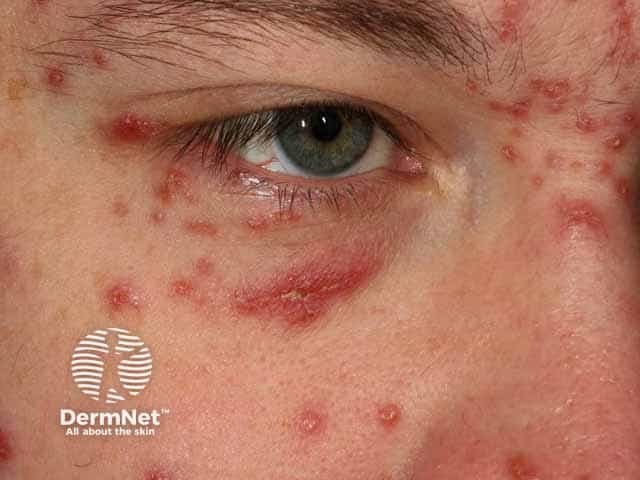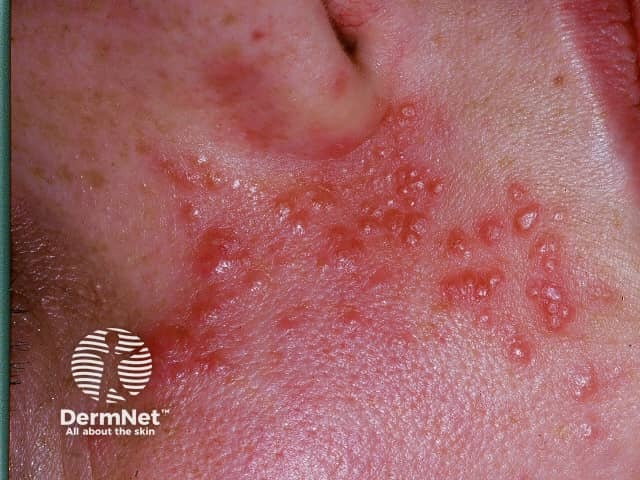Main menu
Common skin conditions

NEWS
Join DermNet PRO
Read more
Quick links
Acne agminata — extra information
Acne agminata
Author: Dr Marisa Taylor MBBS MSc MD (Cardiff), Specialty Doctor in Dermatology; Dr Alun Evans, Consultant Dermatologist, Neath Port Talbot Hospital, Port Talbot, United Kingdom; Chief Editor: Dr Amanda Oakley, Dermatologist, Hamilton, New Zealand, July 2015.
Introduction Demographics Causes Diagnosis Differential diagnoses Treatment
What is acne agminata?
Acne agminata is an uncommon skin disorder characterised by red-brown lumps and bumps on the face, especially the eyelids, forehead, cheeks and chin. It can also affect the armpits.
It was first described by Tilbury Fox as disseminated folliculitis in 1878.
Other names for the disorder include:
- Lupus miliaris disseminatus faciei
- Facial idiopathic granulomas with regressive evolution
- Acnitis of Barthélemy
- Acne telangiectoides of Kaposi
- Tuberculodermas of the face
- Facial idiopathic granulomas with regressive evolution (FIGURE)

Acne agminata

Acne agminata around eyelid

Acne agminata
*Courtesy of Dr Anthony du Vivier
Who gets acne agminata?
Acne agminata is most commonly found in young adults, although any age group may be affected.
What causes acne agminata?
The cause and risk factors for acne agminata remain unknown. It does not appear to be an infection, which has been considered because granulomas are seen on histopathology.
How is acne agminata diagnosed?
Acne agminata is often a clinical diagnosis.
Typical microscopic changes on skin biopsy include epithelioid granulomas within the dermis, which may be caseating even in the absence of tubercle bacilli.
Other investigations are not usually required once a diagnosis of acne agminata has been made, unless there is a suspicion of other diagnoses such as sarcoidosis or tuberculosis (TB), when the following tests may be considered if appropriate.
- Blood tests: full blood count, renal function, interferon gamma assays
- Imaging: chest X-ray
- Tuberculin skin testing (Mantoux)
Differential diagnosis of acne agminata
Clinical and histopathological diagnoses that should be considered include:
- Acne vulgaris: however, comedones are absent in acne agminata, and eyelids are not usally affected in acne
- Rosacea
- Cutaneous TB
- Granuloma annulare
- Cutaneous leishmaniasis
- Sarcoidosis
- Syphilis
What is the treatment for acne agminata?
Untreated, acne agminata persists for 2–3 years and then regresses with scarring.
Several treatments have been tried with some success including:
References
- Dawson GW. Acne agminata. Proc R Soc Med. 1909; 2: 45-48. PubMed Central
- Warren CM. Acne agminata. Proc R Soc Med. 1938; 31 (10): 1178. PubMed Central
- O'Driscoll T, Morgan G. Acne agminata of the eyelid. Proc R Soc Med. 1974; 67(9):869–70. PubMed Central
- Bedlow AJ, Otter M, Marsden RA. Axillary acne agminata (lupus miliaris disseminatus faciei). Clin Exp Dermatol. 1998;23(3):125–8. PubMed
- Uesugi Y, Aiba S, Usuba M, Tagami H. Oral prednisone in the treatment of acne agminata. Br J Dermatol 1996;134(6):1098–100. PubMed
- Scott KW, Calnan CD. Acne agminata. Trans St Johns Hosp Dermatol Soc. 1967; 53(1):60–9. PubMed
- Gupta D, Dewan SP, Kaur A et al. Lupus miliaris disseminatus faciei. Indian J Dermatol Venereol Leprol. 1996; 62(6):371–2. Journal
- Daneshpazhooh M, Ehsani A, Toosi S, Robati RM. Isotretinoin in acne agminata. Saudi Med J. 2007; 28(10):1600-2. PubMed
- Anthony du Vivier. The Atlas of Clinical Dermatology, 4th ed., Figure 24.47, pg. 611, 2013. Elsevier Ltd., London.
On DermNet
Other websites
- Lupus Miliaris Disseminatus Faciei – Medscape Drugs & Diseases
